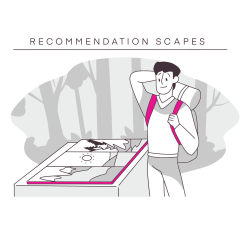Navigating the recommendation space
A promising, avenue for exploring XAI, may be solutions that allow users to navigate the recommendation space. Rather than treating a recommendation as a point solution - a single best outcome - the system could present the user with a ‘landscape’ of outcomes of the recommender and controls to navigate it. A common solution ‘in the wild’ is the use of ordered lists, in music and movie recommenders such as Netflix and Spotify. The user is presented with a set of tiles suggesting multiple outputs of the recommender that might be relevant and is allowed an easy choice between them. E-commerce sites also explain the social context that fed the recommendations “others who bought this item”.
In the academic literature, we find more sophisticated examples of this central idea. Bakalov et al. [1] for example propose the idea of recommendation scapes for controllable personalization. In their approach recommendations are not just ordered list, but they take position in structured and interactive visualization. This helps the user to understand what alternatives the recommender may provide, and how they are related to the ‘best option’.
It is easy to imagine how this proposal can help the physician in the fictional example above. Medical diagnoses have a structure and presenting the outcome of the decision support system with respect to alternative diagnoses, combined with putting different weights to underlying data, might be an effective way to enable the physician to make a more educated decision on how to interpret the system output. We consider alternatives for the navigation of the recommendation space as a potent avenue for XAI although a custom design for each context will be needed.










